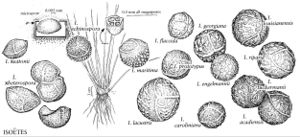Difference between revisions of "Isoëtes flaccida"
Flora 29: 178. 1846.
FNA>Volume Importer |
FNA>Volume Importer |
||
| Line 50: | Line 50: | ||
|publication year=1846 | |publication year=1846 | ||
|special status= | |special status= | ||
| − | |source xml=https://jpend@bitbucket.org/aafc-mbb/fna-data-curation.git/src/ | + | |source xml=https://jpend@bitbucket.org/aafc-mbb/fna-data-curation.git/src/f50eec43f223ca0e34566be0b046453a0960e173/coarse_grained_fna_xml/V2/V2_190.xml |
|genus=Isoëtes | |genus=Isoëtes | ||
|species=Isoëtes flaccida | |species=Isoëtes flaccida | ||
Revision as of 20:48, 16 December 2019
Plants aquatic, emergent. Rootstock nearly globose, 2-3-lobed. Leaves evergreen, bright green, pale toward base, spirally arranged to 60 cm, pliant, gradually tapering to tip. Velum covering entire sporangium. Sporangium wall unpigmented. Megaspores white, 250–500 μm diam., tuberculate to rugulate; girdle smooth. Microspores light brown in mass, 25-33 μm, papillose. 2n = 22.
Phenology: Spores mature in summer.
Habitat: Emergent or in shallow water of lakes, ponds, streams, ditches, and marshes
Discussion
Isoëtes flaccida includes individuals with a variety range of megaspore sizes and textures. Although megaspores are fairly uniform among individuals within a population, considerable variation occurs between populations. A local Florida population with megaspores that are nearly smooth on the proximal faces and low-tuberculate on the distal hemisphere has been described as I. flaccida var chapmanii Engelmann. Isoëtes flaccida var. alata (Small) N. E. Pfeiffer has included plants in which the megaspores are densely tuberculate to rugulate on the proximal faces and have bold, anastomosing ridges on the distal hemispheres.
Isoëtes flaccida hybridizes with I. engelmannii
Selected References
None.

